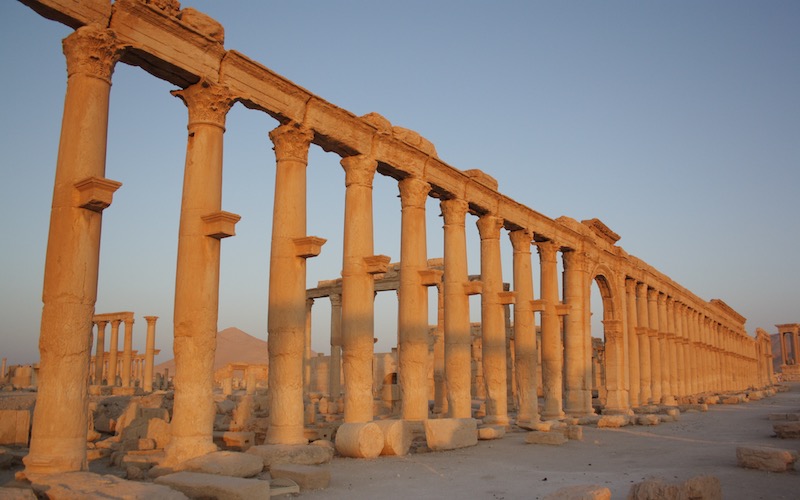
Stronger regulations are needed to combat antiquities trafficking that finances terrorist activity.
The Islamic State (ISIS) is known around the world for its horrendous acts of terrorism. Its status as a global art dealer is less well publicized.
Sales of stolen cultural property and art from conflict zones around the world have helped terrorist organizations like ISIS continue to fund their illegal activities. These complex operations span the globe and implicate parties as diverse as archeologists and Facebook.
The ad hoc nature of domestic regulatory oversight and policing gives rise to a need for legislation that can stem the flow of antiquities revenue going to ISIS, which some estimates place as high as $100 million.
In 2014, ISIS began looting and destroying cultural heritage sites like the famed ancient city of Palmyra. ISIS then sold the items left intact to art collectors around the world. Chiefly Western customers paid generously for irreplaceable goods such as paintings, sculptures, Roman mosaics, and Egyptian sarcophagi. The importance of these “blood antiquities” grew when ISIS began losing access to revenue-producing oil reserves.
ISIS grants licenses to certain approved individuals to sell the artifacts, which are often shipped through Singapore or Thailand before reaching their final destination—a way to obscure their looted origins. ISIS also sometimes holds these items for years before selling them, making them more difficult to trace. One archaeologist has estimated that around 80 percent of antiquities sold online have no legal documentation.
Although the authenticity of artifacts coming out of conflict zones may be doubtful, demand for them remains quite high. Experts think that the art and antiquities business will continue to buoy ISIS because of high international demand and the lower relative risk as compared to selling other types of illegal goods such as drugs.
For these reasons, dismantling the antiquities trade is vital to stopping ISIS.
Countries destabilized by terrorism often have trouble enforcing laws against antiquities smuggling, so the burden falls to the Western nations whose residents import the items.
No single U.S. law exclusively governs the trafficking of stolen cultural artifacts. The Convention on Cultural Property Implementation Act bans the importation of stolen cultural property belonging to any member nation. Similarly, the National Stolen Property Act criminalizes any stolen items crossing state or U.S. borders.
As early as August 2015, the Federal Bureau of Investigation (FBI) warned art collectors and dealers that stolen artifacts were entering the U.S. marketplace. The FBI cautioned that buying looted items from ISIS—or helping cover up these sales—could result in prosecution under a federal law that criminalizes providing “material support or resources” to terrorists. Violations could result in a fine, imprisonment up to 15 years, or both. Any deaths connected with these activities may result in a life sentence for those involved.
The broad definition of “support” gives the statute its teeth, at least in theory. “Support” can include the provision of financial services, training or advice, transportation, lodging, false documents, communications equipment, weapons, and more connected with the sale of blood antiquities. Prosecuting these cases, however, remains challenging because proving “knowledge” of illegal excavation is extremely difficult once an antiquity is taken from its original location.
Furthermore, even though auction houses, art dealers, and bankers are subject to federal anti-money laundering (AML) and know-your-client (KYC) regulations, these regulations do not specify how entities should actually carry out their obligations. Most laws focus narrowly on verifying the legitimacy of transactions, which often involve legitimate buyers and sellers at the final stages, but focus less on the underlying activities that generate these valuable items. Anti-trafficking and AML-related bills have repeatedly failed in Congress, and the issue reemerges each session—yet no comprehensive legislation has passed.
In the absence of congressional action, the U.S. Department of Homeland Security (DHS) works with the U.S. Department of Justice to prosecute crimes related to stolen antiquities. DHS trains agents in the “handling, investigation, and seizure” of other nations’ cultural property, and it also educates non-law enforcement entities such as brokers and potential art buyers on item verification. The U.S. Department of State’s Cultural Antiquities Task Force includes personnel from the previously mentioned federal agencies plus the U.S. Departments of Defense, Interior, and Treasury.
Still, even attempts to strengthen coordination within agencies and between state and local entities have often stalled, weakening their collective ability to slow the trafficking. Congress does not seem keen to take up the issue again soon.
Responding to this lack of regulatory oversight, experts have called for an antiquities-centered verification method like the Kimberley Process, an international certification scheme designed to prevent blood diamonds from entering the global market. Scholars argue that a similar global registry and dealer certification system might stem the flow of blood antiquities.
More recently, law enforcement has encountered a particularly daunting obstacle in its fight to halt ISIS’s operations: Facebook. ISIS has shifted from selling artifacts on sites such as eBay or Amazon and on weapons forums to posting on antiquities-related Facebook pages. Members of these groups trade pointers on how and where to loot, and people can discretely advertise on Facebook Stories by posting antiquities images that disappear after 24 hours.
Stopping these online groups proves difficult because large technology companies such as Facebook generally are not liable for the actions of third parties on their platform. Furthermore, Facebook allegedly deletes antiquities-related pages once they have been flagged as problematic, rather than preserving their content, which could be evidence in potential investigations or trials.
Ironically, some of Facebook’s most significant steps toward AML compliance have come from its desire to launch its Libra cryptocurrency—not from criticisms of its inaction in the face of antiquities trafficking by terrorist groups.
Still, Facebook has taken action at least once before. After a recent BBC exposé, the technology platform reportedly shut down pages through which looted items were apparently sold.
Despite this relative lack of federal oversight and general reluctance of tech giants to reform, anti-antiquities trafficking efforts have been met with some success. But more reforms are needed.
A singular fix cannot stop a complex, evolving antiquities trafficking scheme that spans the globe. Still, strengthening AML-KYC regulations to emphasize the potential liability of buyers, sellers, and intermediaries would have a chilling effect on the market, lowering ISIS’s incentives to loot cultural sites. Harmonizing domestic cultural theft laws and strengthening international cooperation among law enforcement agencies can stop these items from entering Western markets altogether. Finally, continued global anti-terrorism efforts will put pressure on ISIS and force it to divert resources away from the antiquities trade. In combination, these reforms could ensure that the world’s most dangerous art dealer closes its doors.



